
The 14th arrondissement of Paris, officially named arrondissement de l'Observatoire, is one of the 20 arrondissements of the capital city of France.

The 15th arrondissement of Paris is one of the 20 arrondissements of the capital city of France. In spoken French, it is referred to as le quinzième.
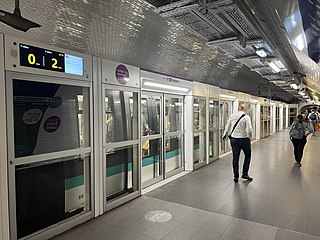
Alésia is a station of the Paris Métro on line 4 in the 14th arrondissement situated in Petit-Montrouge quarter.
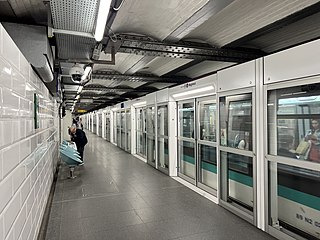
Porte d'Orléans is a station of line 4 of the Paris Métro and a stop on tramway line 3a. It is situated in the 14th Arrondissement, in the quartier of Petit-Montrouge. The station is the former southern terminus of line 4. A terminal loop was provided at the station for trains to turn around to return north towards Porte de Clignancourt. Passengers used to disembark at the arrival platform and then the train proceeded empty via the loop to the departure platform. The extension to Mairie de Montrouge modified the layout of the station, the northbound platform was extended toward the track coming from the former terminal loop to add a new entrance.
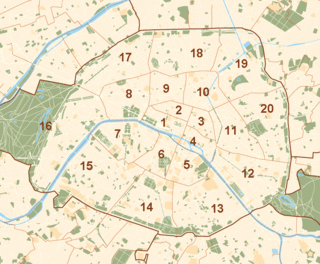
The City of Paris is divided into twenty arrondissements municipaux, administrative districts, referred to as arrondissements. These are not to be confused with departmental arrondissements, which subdivide the larger French departments.

Montrouge is a commune in the southern Parisian suburbs, located 4.4 km (2.7 mi) from the centre of Paris. It is one of the most densely populated municipalities in Europe. After a long period of decline, the population has increased again in recent years.

Wallace fountains are public drinking fountains named after, financed by and roughly designed by Sir Richard Wallace. The final design and sculpture is by Wallace's friend Charles-Auguste Lebourg. They are large cast-iron sculptures scattered throughout the city of Paris, France, mainly along the most-frequented sidewalks. A great aesthetic success, they are recognized worldwide as one of the symbols of Paris. A Wallace fountain can be seen outside the Wallace Collection in London, the gallery that houses the works of art collected by Sir Richard Wallace and the first four Marquesses of Hertford.

Denfert-Rochereau is a station on the Paris Métro in France. An adjacent station with the same name is served by RER B.
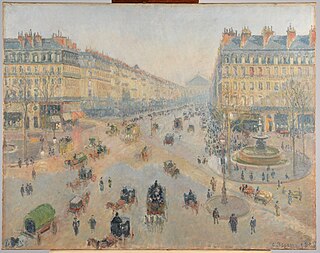
Haussmann's renovation of Paris was a vast public works programme commissioned by French Emperor Napoleon III and directed by his prefect of the Seine, Georges-Eugène Haussmann, between 1853 and 1870. It included the demolition of medieval neighbourhoods that were deemed overcrowded and unhealthy by officials at the time, the building of wide avenues, new parks and squares, the annexation of the suburbs surrounding Paris, and the construction of new sewers, fountains and aqueducts. Haussmann's work was met with fierce opposition, and he was dismissed by Napoleon III in 1870. Work on his projects continued until 1927. The street plan and distinctive appearance of the centre of Paris today are largely the result of Haussmann's renovation.

Parc Montsouris is a public park situated in southern Paris, France. Located in the 14th arrondissement, it was officially inaugurated in 1875 after an early opening in 1869.

The Wall of the Ferme générale was one of the several city walls of Paris built between the early Middle Ages and the mid 19th century. Built between 1784 and 1791, the 24 km wall crossed the districts of the Place de l'Étoile, Batignolles, Pigalle, Belleville, Nation, the Place d'Italie, Denfert-Rochereau, Montparnasse and the Trocadéro, roughly following the route now traced by line 2 and line 6 of the Paris Métro. The wall was demolished in the early 1860s, although elements of some of its gates remain.
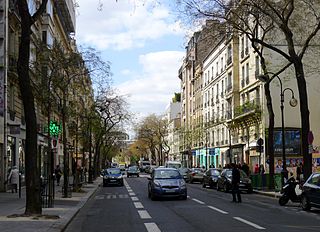
Rue d'Alésia is a major street in the south of Paris, which runs along the entire east-west length of the 14th arrondissement. It is one of the few streets in Paris named after a French defeat, or more precisely, a Gallic defeat: the Battle of Alesia. Lined with acacia trees, the street extends to the east as Rue de Tolbiac into the 13th arrondissement, and to the west as Rue de Vouillé into the 15th arrondissement. It intersects Avenue du Général Leclerc at the Place Victor et Hélène Basch, the location of the Église Saint Pierre de Montrouge, as well as of the Alésia Métro station.

Boulevard Raspail is a boulevard of Paris, in France.
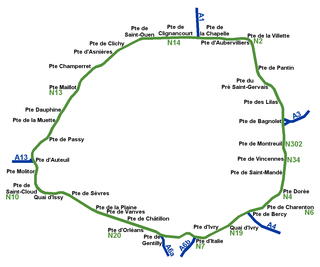
While Paris is encircled by the Boulevard Périphérique, the city gates of Paris are the access points to the city for pedestrians and other road users. As Paris has had successive ring roads through the centuries, city gates are found inside the modern-day Paris.
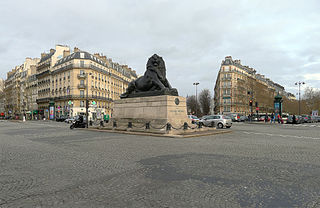
Place Denfert-Rochereau, previously known as Place d'Enfer, is a public square located in the 14th arrondissement of Paris, France, in the Montparnasse district, at the intersection of the boulevards Raspail, Arago, and Saint-Jacques, and the avenues René Coty, Général Leclerc, and Denfert-Rochereau, as well as the streets Froidevaux, Victor-Considérant and de Grancey. It is one of the largest and most important squares on the left bank of the Seine.

Avenue Henri-Martin is an avenue in the 16th arrondissement of Paris, named after the French historian Henri Martin (1810–1883), onetime mayor of the 16th arrondissement.
The Barrière d'Enfer is a pair of tollhouses in Paris that once served as a gate through the Wall of the Farmers-General at the current location of the Place Denfert-Rochereau.
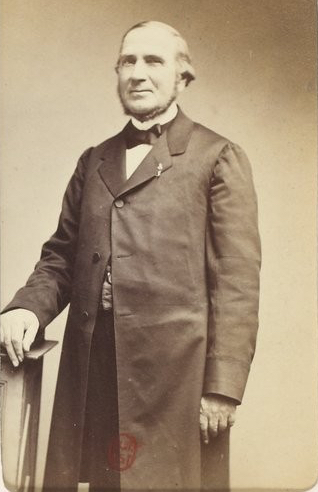
Auguste Prosper Balagny was a French notary and the first mayor of the 17th arrondissement of Paris.
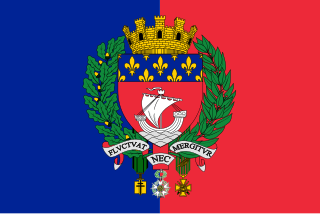
The following outline is provided as an overview of and topical guide to Paris:





















